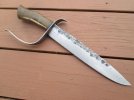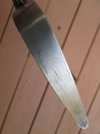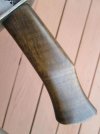G L Drew
Knifemaker / Craftsman / Service Provider
- Joined
- Feb 3, 2005
- Messages
- 4,740
Sometimes when I am at my forge I pay attention to the voices in my head and come up with a knife that is a little different from my usual work.
Forged from 1/4 inch 5160 steel heat treated and tempered to 58-60 Rc
Flat grind with a Scotch Bright finish
Forge texture on the flats
The guard was forged from an old wagon tire and etched to bring out the grain of the wrought iron
Stabilized and dyed curly ash handle
Overall length: 16 inches
Blade: 10 3/4 inches
Weight: 1 pound, 2 oz.
Leather sheath (no belt loop-this style was traditionally worn under a belt or sash. I could make a frog if someone would like a belt loop)
$240 delivered to the US or Canada. My PayPal account and email address is gldrewknives@gmail.com Please contact me for other payment methods or overseas shipping costs.





Forged from 1/4 inch 5160 steel heat treated and tempered to 58-60 Rc
Flat grind with a Scotch Bright finish
Forge texture on the flats
The guard was forged from an old wagon tire and etched to bring out the grain of the wrought iron
Stabilized and dyed curly ash handle
Overall length: 16 inches
Blade: 10 3/4 inches
Weight: 1 pound, 2 oz.
Leather sheath (no belt loop-this style was traditionally worn under a belt or sash. I could make a frog if someone would like a belt loop)
$240 delivered to the US or Canada. My PayPal account and email address is gldrewknives@gmail.com Please contact me for other payment methods or overseas shipping costs.





Last edited:
